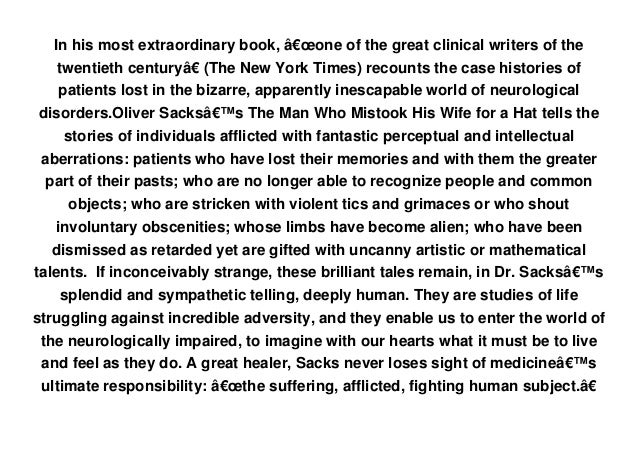

It is at this intersection that Sacks considers the way brain damage and other neurological conditions interfere with his patients’ “souls.” As a neurologist, he seeks ways to help patients rehabilitate all parts of themselves. Sacks adopts Luria’s “romantic” approach to neurology and views his case studies at what he calls an “intersection of fact and fable” (v). Luria empathetically viewed patients as a spirit-one with an imagination, sense of morality, and desire for human connection and relationships. Luria influenced Sacks’s medical understanding of neurology and taught that a patient is more than just a mind. Luria, a Russian neuropsychologist whose theories about neurology emerged from treating patients during the Russian Civil War. Sacks frequently refers to his colleague and predecessor, A. Sacks compares neurological patients to archetypal figures in classical fables, explaining that he alludes to both case studies and literary tales throughout the book to emphasize the fantastical nature of his patients’ experiences.

Sacks groups his stories into four parts: “Losses,” “Excesses,” “Transports,” and “The World of the Simple.” Sacks structures each case history as individual chapters to convey his patients’ unique qualities and stories, thus making them fully human to the reader.

However, injuries to the right hemisphere are just as common, though they often present as more “bizarre.” In this collection, Sacks relays 24 stories of his patients who experienced unusual brain injuries or neurological conditions. Most neurological studies are conducted on the left hemisphere of the brain because that is the area that processes language and schema. In the Preface to The Man Who Mistook His Wife for a Hat, Sacks pinpoints the core of his work: “Neurology’s favorite word is ‘deficit’” (5). The author uses outdated, offensive terms for people with intellectual disabilities throughout, which may be replicated in this study guide only in direct quotes of the source material. This makes the book applicable and engaging, asking readers to imagine alternate states of being and question how their own brains work, what they are for, and how those functions help make any person “whole.”Ĭontent Warning: This book was published in 1985 and does not reflect respectful, inclusive language when discussing people with disabilities. He also refers to the works of fiction writers like Jorge Luis Borges to help readers understand how a neurological condition might affect a person’s lived experience. Sacks often quotes philosophers like Ludwig Wittgenstein and Friedrich Nietzsche. Especially in the cases where Sacks does not have easy answers, he raises philosophical questions about what it means to be a whole human being. Although the book is written using complex neurological terminology, it is designed to be overall accessible.


 0 kommentar(er)
0 kommentar(er)
